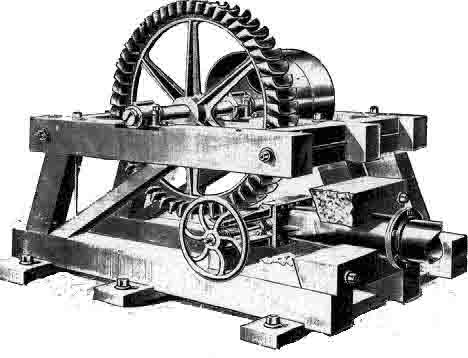
|
Newsletter
Samuel Knight Chapter
Society for Industrial Archeology
Issue Number 13
December 1, 2002
|
Contents:
This may be your last
issue. Please click for
details.
Copyright © 2002-2003 Samuel
Knight Chapter of the Society for Industrial Archeology.
The Newsletter is
published in December, April and August, with special issues when they are
needed.
The Chapter web site has
been moved to the SIA headquarters site:
http://www.sia-web.org/chapters/knight/knight.html
Chapter News
Annual Chapter Meeting
Special thanks to former Chapter President Andy Fahrenwald
for hosting the annual Chapter meeting at Knight Foundry in Sutter Creek, CA on
October 5, 2002. The turnout surpassed
even our most optimistic projections, with a total of 17 members and friends.
In Chapter business, Treasurer McCauley reported that the Chapter
bank balance was $1540.56 as of October 1. The new Board will review the 2003
budget. The new Chapter Board consists of:
·
President: Tony
Meadow
·
Secretary/Treasurer: Jay McCauley
·
Board Member: Noel Kirshenbaum
·
Board Member: David Lindquist
·
Board Member: Scott See
·
Board Member: R. Scott Baxter
·
Board Member: John de Marchi
The Chapter thanks departing Board Member Nate Shugars for
his hard work and contributions.

The new Board: R. Scott Baxter, Scott See,
David Lindquist, Noel Kirshenbaum, John de Marchi, Tony Meadow and Jay
McCauley.
The membership did some brainstorming on potential activities
and events. Members agreed to follow up
on the most interesting ones. The members
agreed informally not to seek IRS 501(c)(3) status due to the significant
record keeping burden and the lack of a clear need to be recognized by the IRS
as a charity. This decision can be
re-examined if circumstances change.
They also agreed that a Chapter web site was an important communications
vehicle and it should be revived. The
membership agreed that the mailing list should be trimmed and that email should
be used to contact members who agree to use it. Due to the size of current newsletters, they will still be
distributed in hard copy, but they will be put up on the Chapter web site
shortly after distribution.
Andy gave the group a delightful tour of the machine shop and
the pattern shop. One particularly
interesting moment occurred as he started up what is believed to be the oldest
operating machine tool in the US, a belt driven lathe. Andy discussed the dilemma of preservation
versus use, a central issue for the Foundry and other organizations like
it. The Foundry is vastly more interesting
if it is a living organization, not merely a static snapshot preserved "under
glass". However, how many more pieces
can be turned on this historically significant artifact before it wears out or
breaks? The Foundry has stuck a balance
that considers both sides of the issue.
All the members were impressed at how much progress has been made at the
Foundry, and the real IA that is taking place there.
Thanks to all the members who attended; it was an excellent
meeting.
Chapter Event: Shell Refinery Tour,
January 2, 2003
NOTE: Some of the renewal acknowledgement letters had an incorrect
date. The correct date is Thursday,
January 2, 2003.
The Chapter will start 2003 with a tour of the Shell Refinery
in Martinez, on Thursday, January 2, 2003.
We will meet at 9:45 AM at the Shell Oil Alumni Museum, 1700 Pacheco
Blvd., Martinez, CA. The tour will complete about 12:30. The tour will
primarily be via Shell-supplied bus, and is suitable for interested
children. This is a unique opportunity
to see a major industrial complex with deep historical roots dating back to
1915. Please contact Tony Meadow for details
if you will be able to attend.
As long as you're in
the neighborhood, don't forget to check out the new Albert P. Zampa Bridge
under construction between Vallejo and Crockett. Also of IA interest in the
area are the Benicia Arsenal which was established before the Civil War, the
Benicia State Capitol, the mothball fleet in Suisun Bay, and the Western
Railway Museum in Rio Vista. Just up
I-680, the Budweiser plant in Fairfield offers tours, as does the Jelly Belly
factory, although combining them would seem to be a bad idea.
Chapter Events in the Planning Stage
At the October 23, 2002 Board meeting, the list of possible
Chapter events was winnowed to a more manageable set of high interest
candidates. These include:
·
SP's Sacramento Shops, now part of the California State
Railroad Museum. The shops are one of
the most important IA sites in the Western US and are the focal point for the
new Museum of Railroad Technology, an ambitious venture by CSRM. We are working with CSRM for a possible
April/May visit.
·
Mare Island Naval Shipyard. An important IA site with a rich history stretching back to
1854. If any of our readers has
experience at Mare Island, it might help us put together a more interesting
visit.
·
Folsom Hydroelectric Plant. The first plant built by PG&E, operated from 1895 to 1952.
·
Earthgrains Bakery in Oakland, CA. The yummy smell as you drive up I880 is now
gone, the victim of tightened air pollution restrictions, but it's still there
inside this large industrial bakery.
This will be a weekday visit.
There are several other possible
events being investigated. We are
always looking for members' ideas on possible Chapter events.
Mailing List Cleanup
The Chapter membership agreed that the current mailing list
should be reviewed. If you renewed your
Chapter membership in 2000 or later you will continue to receive the newsletter.
If you have not yet renewed for 2003, now would be a good time to do so!
Even though reproduction and postage have gone up a great
deal, the Chapter newsletter is still our most important vehicle for reaching
our broader community of members and friends.
So, we want to make sure that the recipients of the newsletter are still
interested in the Chapter. If you are
not a member or haven't renewed since 2000, please drop Jay McCauley an email
or note if you wish to continue to receive the Chapter newsletter. If we don't hear from you, we may stop
sending newsletters. They will be
available on the new Chapter web site http://www.sia-web.org/chapters/knight/newsletters.html
. The web newsletters have the same
basic content as the hardcopy, but include additional features such as color
photos.
Meet a Member
R. Scott Baxter
(This is a new section that is intended to let the membership
get to know each other a little better.
If you'd like to participate, drop me a short biographical sketch. - Jay)
Scott Baxter is a practicing historical archaeologist with 12
years of experience in the field, and is a partner in the cultural resource
firm Past Forward, Inc. He received a
B.A. in anthropology from CSU, Bakersfield and a M.A. in anthropology from the
University of Nevada, Reno. He has been
a member of the SIA since 1995. Interests
in industrial archaeology include mining, the petroleum industry, and the
evolution of technology.
OIL EXPLORATION AT SQUAW FLAT
R. Scott Baxter

Cable Tool Drilling Rig (from
http://www.lloydminsterheavyoil.com/cable.htm)
Nestled
high in the rugged Piru Mountains, 12 miles northeast of the town of Fillmore,
is a small, grassy meadow known as Squaw Flat.
The meadow is surrounded by dense chaparral, and is cut by a deep
drainage that flows sulfurous water year round. Quail, deer, coyotes, and bobcats frequent the meadow, which
seems a pristine picture of nature. But
tucked away in surrounding drainages are remnants of an industrial past.
In the 1870s the Cohn family was drawn here,
and reportedly constructed an adobe house and maintained a peach orchard
here. Their interest in the land
changed after the turn of the century, as the promise of mineral wealth loomed
large. Oil had been discovered at the
Sespe Oil Field to the south, and it appeared that chances were good the
deposit extended north to their land.
Around 1912 the first oil well was started at Squaw Flat. Known as Big Chief No. 1, it hit small
quantities of oil, and proved so promising that the Cohn's filed a placer claim
on the land to protect the new find.
Soon others joined in. Squaw Flat Oil Company, New Moodey Gultch, Big
Chief, Houston & Cohn, Beesum, Stansburry, Inc., and Border Oil Company all
worked on or around Squaw Flat drilling exploratory wells. No less than seven wells were drilled
here. Some on the flat, but others on
ridge tops or hillsides, that were bladed flat for the drill rig and related
equipment. Most of the wells were
drilled with what are known as cable tool rigs, drills that hoist a heavy bit
and smash it into the earth, breaking up the rock and soil. These drills were powered by portable steam
engines, and locomotive type boilers.

Boiler at Houston and Cohn
Due to the long commute and rugged location workers stayed at
the job site. A boarding house and two
bunkhouses were erected on the flat to provide food, shelter, and even a hot
bath.
By
1954 it was apparent that Squaw Flat would never yield the quantities of oil
that the Cohn's had hoped for. Drilling
stopped, and the buildings and equipment abandoned. In 1970 the Cohn's sold the land to the U.S. Forest Service. Now scattered about the hills are remains of
a once promising industry. Derricks
still stand on hill tops, boilers are tucked away in small drainages, oil tanks
sit half full, the collapsed bunk and boarding houses are slowly returning to
the earth, and a slow trickle of water gurgles out of an abandoned well,
feeding the drainage that flows through Squaw
Flat. The Forest Service now manages
the remnants of Squaw Flat's industrial past as a cultural resource.

For more detailed information see:
R. Scott Baxter 2002 Industrial and Domestic Landscapes of a
California Oil Field. Historical
Archaeology 36(3): 18-27.
Related Sites (physical and web)
West Kern Oil Museum, 1168 Wood St, Taft, CA. http://www.westkern-oilmuseum.org
California Oil Museum, P.O. Box 48,
1001 E. Main St.
Santa Paula, CA 93061 http://www.oilmuseum.net/
Floating IA - The S.S. Jeremiah O'Brien
Jay McCauley
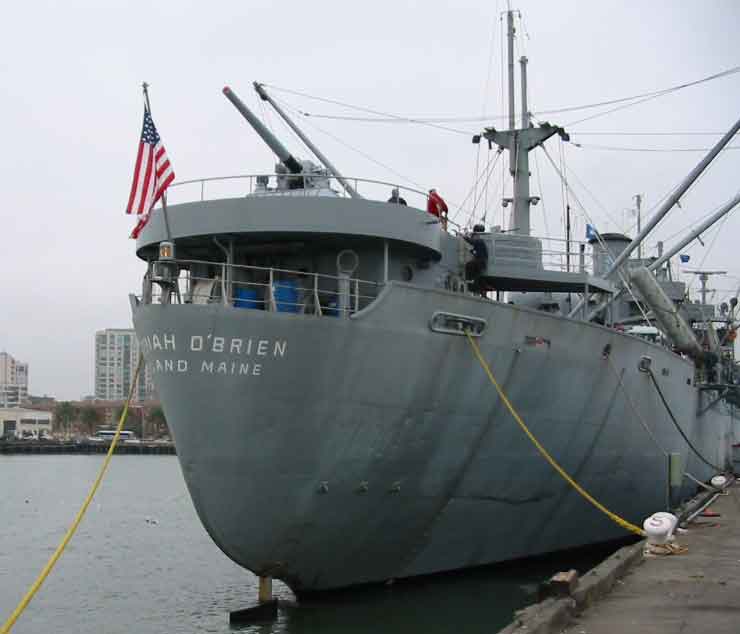
S.S. Jeremiah O'Brien in San Francisco
The
morning fog still shrouded parts of the Bay when we boarded the S.S. Jeremiah
O'Brien, a living piece of IA, for a leisurely cruise to Sacramento in August
2002. The O'Brien is one of a handful
of surviving Liberty Ships.
The Liberty Ship was conceived as a response to the enormous
loss of shipping to German U-Boats during the early days of World War II. Losses of ship tonnage far exceeded the rate
at which new ships could be built. As
an island nation, the "tonnage war" threatened Great Britain's ability to
continue the war.
A program launched at the end of World War I, the so-called Hog Island ships,
demonstrated that ships could be built in a more standardized, modular fashion. Now the site of the Philadelphia
International Airport, Hog Island was a huge (50 ways) shipyard was constructed
from scratch, a preview of similar efforts around the country to build the 18
new shipyards dedicated to the construction of Liberty Ships. The Hog Island
program was tinged by financial scandal, and never achieved the construction
rates that the Liberty Ship program did, so had virtually no impact on the war
effort. In fact, most of the Hog Island
ships were launched after the war was over!
Except for Hog Island, prior to the Liberty Ship,
shipbuilding in the US was a small industry, and nearly every vessel was
unique. Construction of a ship would take several months or more and required
many skilled craftsmen. The Liberty
Ship changed all of that.
The ships' design was standardized and both simple to build
and to operate. Every one of the 2,711
Liberty Ships built was nearly identical.
Standardization benefited the effort in many ways. Each ship required very little new
engineering. Workers required less
training and became more and more proficient at the construction of the Liberty
Ships; now we call this the learning curve effect. Simplicity was the rule. The central tenet of the Liberty Ship program
was to produce as many ships as possible in the shortest possible time. These boxy "ugly ducklings" had most of
their hull plates as simple, flat pieces of steel, requiring less of the
complex shaping of the hull plans for more elegant designs. Standardization also allowed for economies of
scale in producing component parts. Factories
throughout the US were involved in the effort, not just the specialized firms
near shipyards along the coasts. Standardization
and simplicity also made it easier to man the ships. Crew training was simplified, and a crewman from one ship would
be right at home on another Liberty Ship.
Steam Driven Cargo Winch
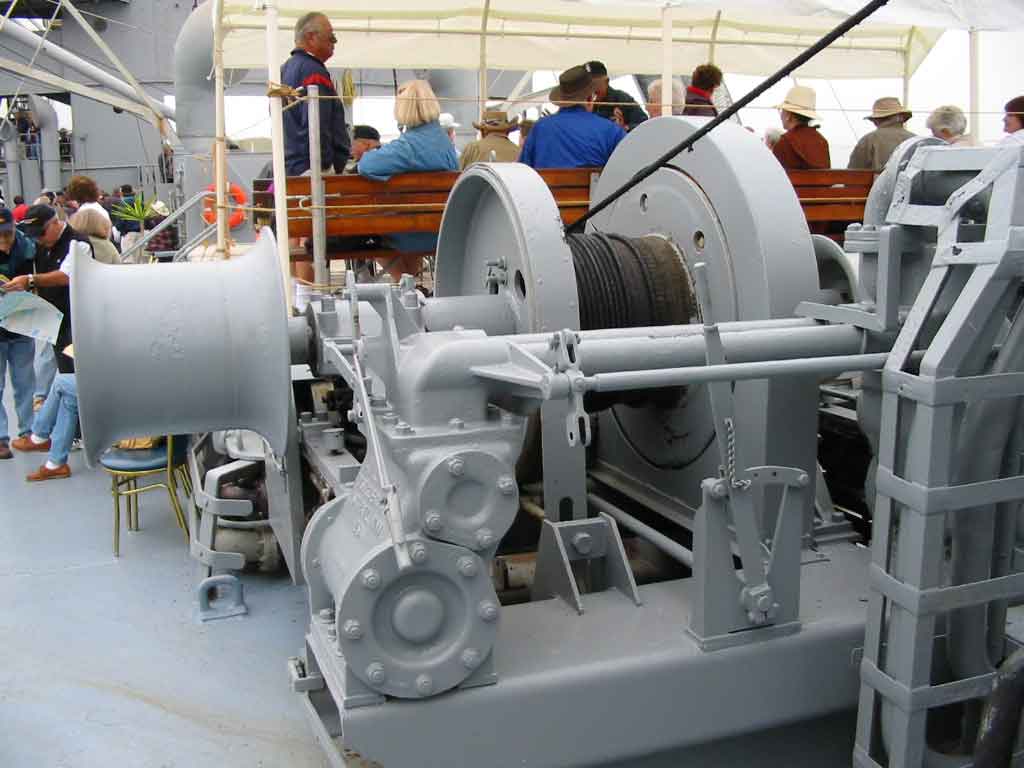
The
design was modular, allowing large sections of the ships to be constructed
independently, then moved into place and welded together to complete the
vessel. This technique resulted in an unprecedented
assembly line style of ship "manufacturing".
Modular construction also allowed easy access to hard to reach areas in
the finished vessel. Plumbing,
electrical and other subsystems could be installed in the modules while areas
were accessible, then connected together as the modules were assembled. Modular
construction was so successful that the S.S. Robert E. Peary was built in just
four days at the Kaiser shipyard in Oakland.
The Peary made her maiden voyage just seven days after her keel was
laid! The O'Brien was constructed in 46 days in mid-1943 at the New England
Shipbuilding Corporation shipyard in South Portland, Maine. In contrast, Hog Island ships, which were
similar in concept and size, required on average over 200 days to complete,
with some requiring as much as 400.
Another novel aspect of the Liberty Ship was its all welded
construction. Welding is far more
efficient than riveting, which had been the primary construction mode since the
dawn of modern shipbuilding. The first welded ship in the US was produced in
1940, so the Liberty Ships were somewhat guinea pigs for the technique. There were some problems with welding,
particularly embrittlement in very cold temperatures and stress cracking, but
these were remedied very early in the program.
The Liberty Ship program, like other defense industries, also
changed the face of the workforce by recruiting and training thousands of women
and members of minorities. At least in the Liberty shipyards, Rosie wasn't a riveter,
she was a welder.
Liberty Ships are powered by a triple expansion reciprocating
steam engine. The choice of this type
of engine over the more modern turbine engines was motivated, as were most
design choices for the Liberty Ship program, by a desire to build the ships as
quickly as possible. It is much easier
to build a reciprocating steam engine than a turbine. The simplicity of the
reciprocating engine's construction increased the number of manufacturers who
could build them. The Chapter visited
one of these manufacturers, the former Hendy Iron Works in Sunnyvale, in
1997. The O'Brien's engine has been
seen in several movies, the most notable of which was Titanic.
The ship cruises at around eight to ten knots, so the trip
from Pier 42 in San Francisco to the Port of Sacramento took almost ten
hours.
The O'Brien is the last surviving ship to have participated
in the D-Day landings in Normandy. In
1994, she sailed to Normandy to participate in the events commemorating the 50th
anniversary of the landings, a journey that took five months.
On Friday, August 30,
2002 an ocean breeze chilled the over 500 passengers boarding the O'Brien.
Almost exactly on time, the lines holding the O'Brien to Pier 42 were cast off,
and tugboats eased her into the Bay.
At lunchtime as we passed under the new Carquinez Bridge, the
passengers could see the spinning of the main suspension cables, literally a
once in a lifetime sight. The new
bridge will replace one of the oldest major bridges in the Bay Area, the 1927
Carquinez Bridge, which will be torn down. (Look for an article on the Carquinez
bridges in the next newsletter. - Jay)
The Carquinez Straits are a heavily industrialized area,
including the Shell Refinery at Martinez, the site of a forthcoming Chapter Event
on January 2, 2003. The Straits connect
to Suisun Bay, where the O'Brien had spent several years as part of the
"Mothball Fleet". There are stories of
the ship being moved around to avoid being cannibalized for parts or even
scrapped. Fortunately, these efforts
preserved the O'Brien. On the South
shore of Suisun Bay, the passengers saw the changed face of ocean commerce, as
a double stack container train carried containers eastward that had been off
loaded at Oakland or Richmond. Break
bulk cargo ships like the O'Brien and the masses of longshoremen needed to load
and unload them were completely replaced by the containership revolution.
From an IA perspective, the O'Brien is a unique time
capsule. She was never intended to last
this long. The Government felt that
these vessels were expendable, and would fulfill their mission if they
completed only one voyage. The O'Brien
has been lovingly preserved, and restored to operation by a dedicated corps of
volunteers. She offers insight and
hands on experience to an era in maritime commerce that has completely disappeared. Her machinery spaces are more from the 19th
century than the 20th. She
also shows the types of choices in design and implementation that the
emergencies of war bring on. Finally,
she is a living, breathing monument to the men and women who built the ships
that helped win the war, and to the men who served aboard them.
Resources
http://www.ssjeremiahobrien.org
- Web site for the O'Brien, many useful links, references to books etc. The O'Brien is berthed at Pier 45 in San
Francisco.
http://www.wwiitechpubs.com/dock/nv-usa/nv-usa-ss-liberty-ship/nv-usa-ss-liberty-ship-ftr.html (URL longer valid)
- Detailed technical article on the Liberty ships. One minor error in that the
engine is described as a turbine. (There have been occasional problems reaching this site.)
http://www.andrew.cmu.edu/~pt/liberty/hog_island.html
- overview of the Hog Island ships.
http://www.blancmange.net/tmh/articles/hogisle.shtml
- long article about the scandal of the Hog Island shipyard. Very biased author.
Bonus Images
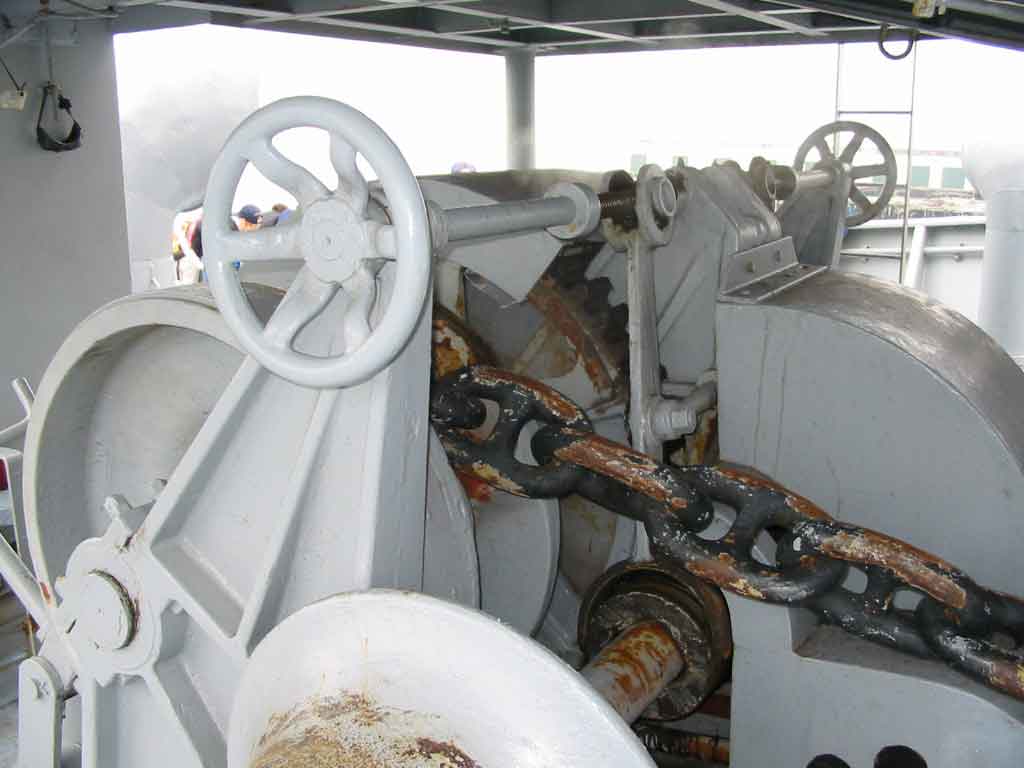
Anchor Winch

President Roosevelt!
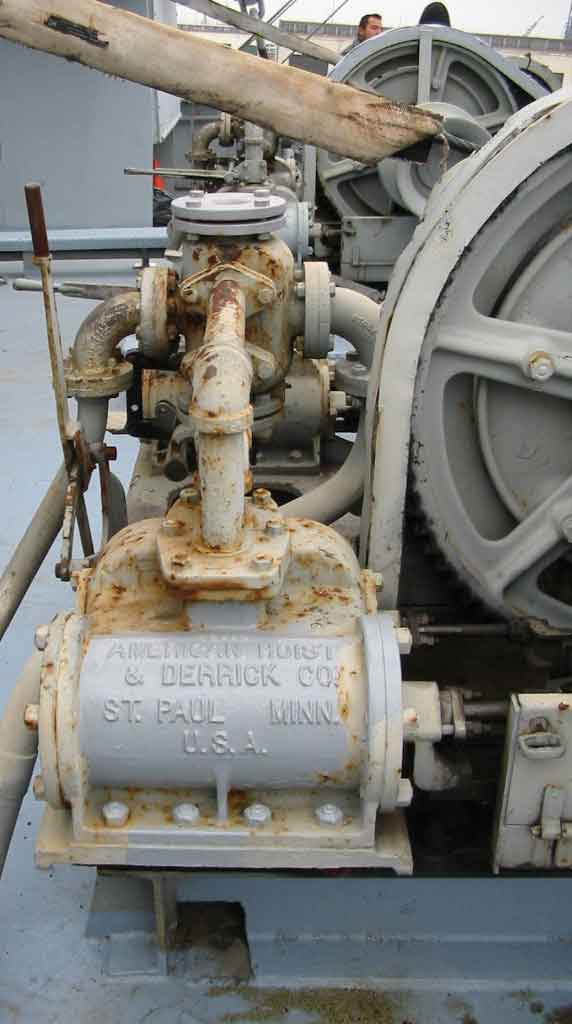
Parts for the Liberty Ships came from all over the US.
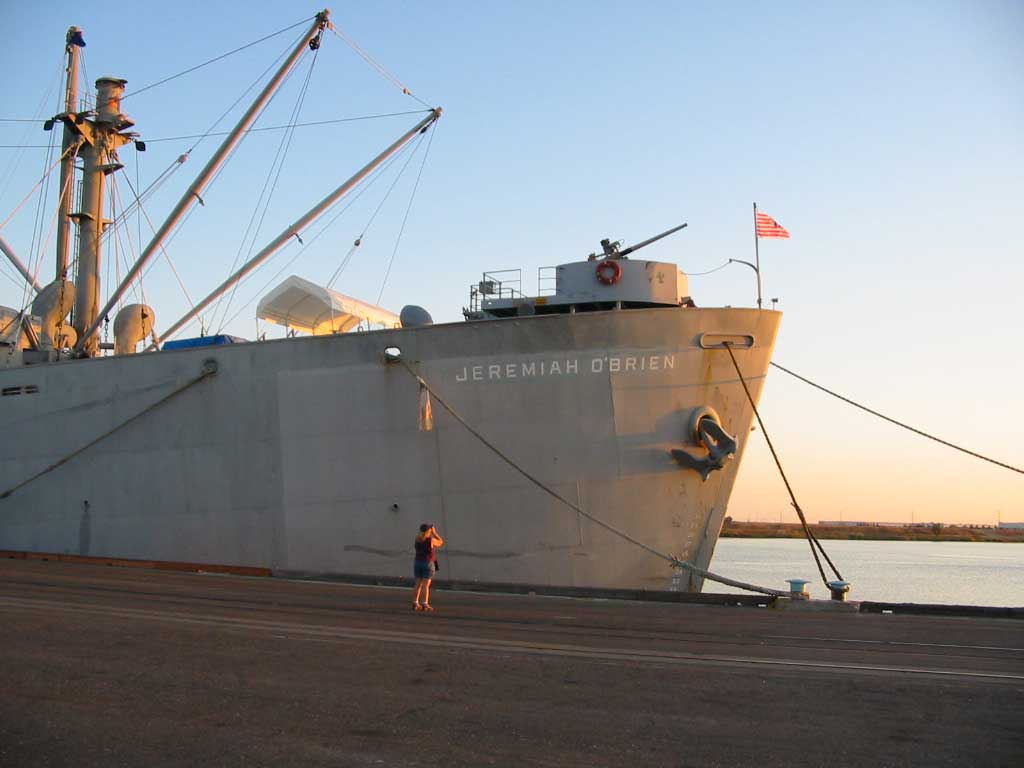
Docked in Sacramento
Contact and Membership Information










